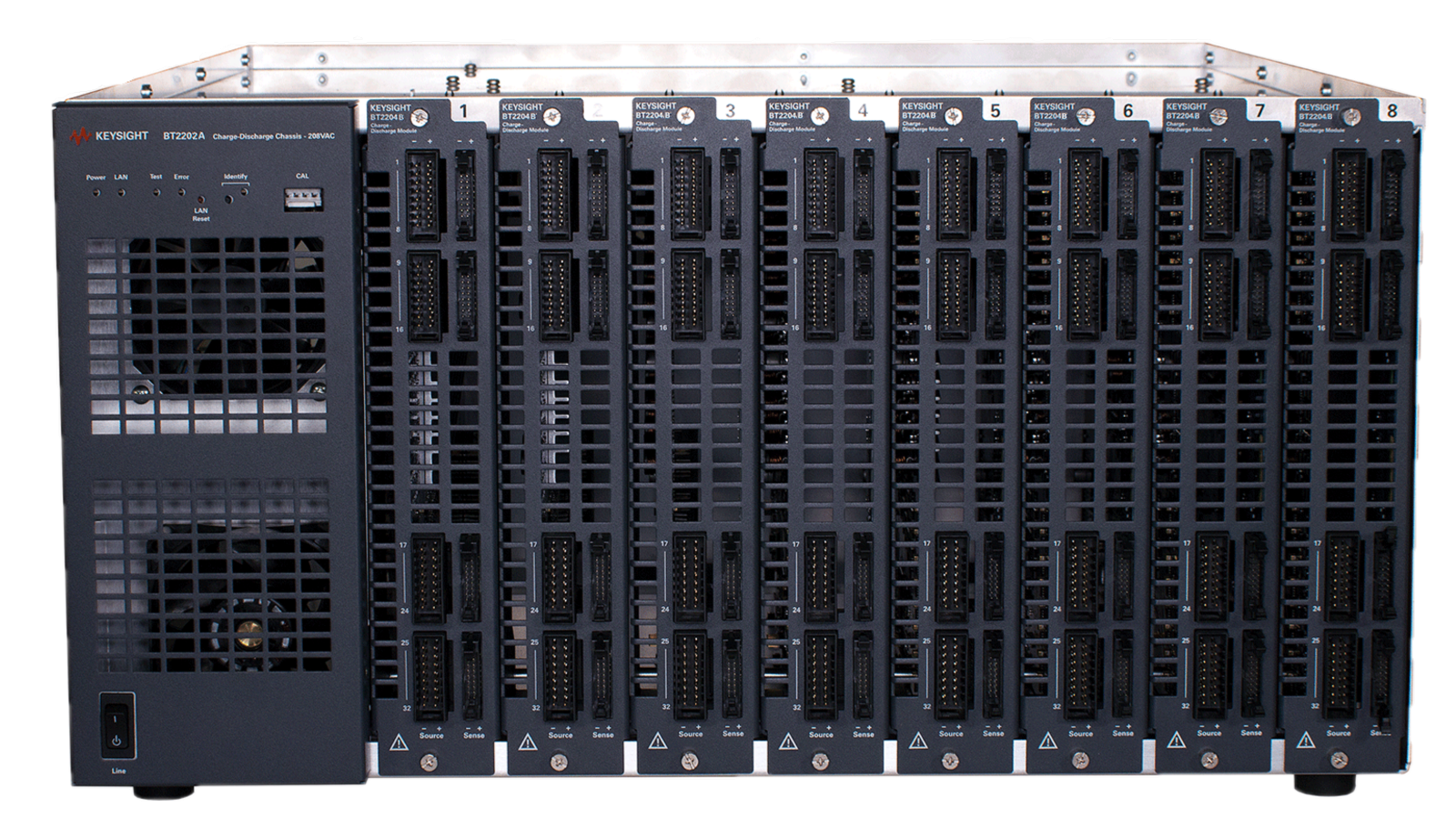How to Form and Cycle Lithium-Ion Cells


Measuring lithium-ion cells with a scalable, adaptable charge-discharge solution
Electric battery lithium-ion cell chemistry is rapidly evolving to offer larger capacities, faster charging, and lower-cost cells, often using locally sourced materials. To rapidly prototype cells, manufacturers need a flexible formation solution. Forming cells requires a multistep charge-discharge process, creating a high-quality solid electrolyte interphase (SEI) layer. A formation plan uses many cycles of varying time and charging currents.
Once a cell forms, several tests characterize its performance and determine its cycle lifetime. Cycle lifetime depends on charge rates, depth of charge, and environmental temperature. Fully understanding a cell's cycle lifetime is a time-consuming process but one that enables original equipment manufacturers to make critical trade-offs between performance and longevity. A cell cycling solution must quickly adapt to new chemistries and high-power cells. It must also scale to handle increasing cell volumes.

Lithium-ion cell formation and cycling solution
Explore products in our lithium-ion cell formation and cycling solution
-
![BT2204B 32 Channel Charge-Discharge Module 6 V, 6.25 A]()
BT2204B 32 Channel Charge-Discharge Module 6 V, 6.25 A
-
![BT2202A Charge-Discharge Chassis for 400 VAC 3-phase]()
BT2202A Charge-Discharge Chassis for 400 VAC 3-phase


How to Form and Cycle Lithium-Ion Cells
BT2204B 32 Channel Charge-Discharge Module 6 V, 6.25 A
32-Channel Module Li-ion Cell Formation and Lifetime Cycling Solution
Specs
| Type |
|
| Maximum current per output | 6.25 A |
| Maximum power | 1200 W |
| Maximum voltage per output | 6 V |
| Number of Outputs | 32 |
| Adjustable Slew Rate | No |
| Regenerative Power | Yes |
| Arbitrary Waveform Generation | No |
| Command Processing Time | 1 s |
| Measurement Accuracy | N/A |
| Noise and Ripple | N/A |
| Output Response Time | N/A |
| Programming Accuracy | N/A |
| Applications |
|


How to Form and Cycle Lithium-Ion Cells
BT2202A Charge-Discharge Chassis for 400 VAC 3-phase
400 V Mainframe Li-ion Cell Formation and Lifetime Cycling Solution
Specs
| Auxiliary Voltage Measurement Input | No |
| Type |
|
| Maximum current per output | N/A |
| Maximum power | 875 W |
| Maximum voltage per output | 6 V |
| Number of Outputs | 32 |
| Input Voltage | 480 V |
| Applications |
|
Discover resources and insights
Additional resources for lithium-ion cell formation and cycling
-
Application note
Assure Well-Matched Response Times of Self-Discharge Current Measurements
-
Configuration guide
Verify the Number of Physical Channels Required for Charge-Discharge Applications
-
Case study
Discover How an E-mobility Manufacturer Implemented Keysight Cell Formation Solution
-
Datasheet
Charge-Discharge Platform
-
Application note
Assure Well-Matched Response Times of Self-Discharge Current Measurements
-
Configuration guide
Verify the Number of Physical Channels Required for Charge-Discharge Applications
-
Case study
Discover How an E-mobility Manufacturer Implemented Keysight Cell Formation Solution
-
Datasheet
Charge-Discharge Platform
Related use cases
-
![How to Test Automotive ECU Power Performance]() segmentation:funnel/mofu,segmentation:business-unit/EISG,segmentation:campaign/Automotive_Energy,segmentation:product-category/AC_DC_Power_Sources_Loads,keysight:dtx/solutions/facets/development-area/power,keysight:product-lines/sp,keysight:dtx/solutions/facets/design-and-test-product/power-supply,keysight:dtx/solutions/facets/workflow-stage/functional-test,keysight:dtx/solutions/facets/industry/automotive,segmentation:product-category/AC_DC_Power_Sources_Loads/DC_Power_Suppliessegmentation:funnel/mofu,segmentation:business-unit/EISG,segmentation:campaign/Automotive_Energy,segmentation:product-category/AC_DC_Power_Sources_Loads,keysight:dtx/solutions/facets/development-area/power,keysight:product-lines/sp,keysight:dtx/solutions/facets/design-and-test-product/power-supply,keysight:dtx/solutions/facets/workflow-stage/functional-test,keysight:dtx/solutions/facets/industry/automotive,segmentation:product-category/AC_DC_Power_Sources_Loads/DC_Power_Suppliessegmentation:funnel/mofu,segmentation:business-unit/EISG,segmentation:campaign/Automotive_Energy,segmentation:product-category/AC_DC_Power_Sources_Loads,keysight:dtx/solutions/facets/development-area/power,keysight:product-lines/sp,keysight:dtx/solutions/facets/design-and-test-product/power-supply,keysight:dtx/solutions/facets/workflow-stage/functional-test,keysight:dtx/solutions/facets/industry/automotive,segmentation:product-category/AC_DC_Power_Sources_Loads/DC_Power_Suppliessegmentation:funnel/mofu,segmentation:business-unit/EISG,segmentation:campaign/Automotive_Energy,segmentation:product-category/AC_DC_Power_Sources_Loads,keysight:dtx/solutions/facets/development-area/power,keysight:product-lines/sp,keysight:dtx/solutions/facets/design-and-test-product/power-supply,keysight:dtx/solutions/facets/workflow-stage/functional-test,keysight:dtx/solutions/facets/industry/automotive,segmentation:product-category/AC_DC_Power_Sources_Loads/DC_Power_Suppliessegmentation:funnel/mofu,segmentation:business-unit/EISG,segmentation:campaign/Automotive_Energy,segmentation:product-category/AC_DC_Power_Sources_Loads,keysight:dtx/solutions/facets/development-area/power,keysight:product-lines/sp,keysight:dtx/solutions/facets/design-and-test-product/power-supply,keysight:dtx/solutions/facets/workflow-stage/functional-test,keysight:dtx/solutions/facets/industry/automotive,segmentation:product-category/AC_DC_Power_Sources_Loads/DC_Power_Suppliessegmentation:funnel/mofu,segmentation:business-unit/EISG,segmentation:campaign/Automotive_Energy,segmentation:product-category/AC_DC_Power_Sources_Loads,keysight:dtx/solutions/facets/development-area/power,keysight:product-lines/sp,keysight:dtx/solutions/facets/design-and-test-product/power-supply,keysight:dtx/solutions/facets/workflow-stage/functional-test,keysight:dtx/solutions/facets/industry/automotive,segmentation:product-category/AC_DC_Power_Sources_Loads/DC_Power_Suppliessegmentation:funnel/mofu,segmentation:business-unit/EISG,segmentation:campaign/Automotive_Energy,segmentation:product-category/AC_DC_Power_Sources_Loads,keysight:dtx/solutions/facets/development-area/power,keysight:product-lines/sp,keysight:dtx/solutions/facets/design-and-test-product/power-supply,keysight:dtx/solutions/facets/workflow-stage/functional-test,keysight:dtx/solutions/facets/industry/automotive,segmentation:product-category/AC_DC_Power_Sources_Loads/DC_Power_Suppliessegmentation:funnel/mofu,segmentation:business-unit/EISG,segmentation:campaign/Automotive_Energy,segmentation:product-category/AC_DC_Power_Sources_Loads,keysight:dtx/solutions/facets/development-area/power,keysight:product-lines/sp,keysight:dtx/solutions/facets/design-and-test-product/power-supply,keysight:dtx/solutions/facets/workflow-stage/functional-test,keysight:dtx/solutions/facets/industry/automotive,segmentation:product-category/AC_DC_Power_Sources_Loads/DC_Power_Suppliessegmentation:funnel/mofu,segmentation:business-unit/EISG,segmentation:campaign/Automotive_Energy,segmentation:product-category/AC_DC_Power_Sources_Loads,keysight:dtx/solutions/facets/development-area/power,keysight:product-lines/sp,keysight:dtx/solutions/facets/design-and-test-product/power-supply,keysight:dtx/solutions/facets/workflow-stage/functional-test,keysight:dtx/solutions/facets/industry/automotive,segmentation:product-category/AC_DC_Power_Sources_Loads/DC_Power_Suppliessegmentation:funnel/mofu,segmentation:business-unit/EISG,segmentation:campaign/Automotive_Energy,segmentation:product-category/AC_DC_Power_Sources_Loads,keysight:dtx/solutions/facets/development-area/power,keysight:product-lines/sp,keysight:dtx/solutions/facets/design-and-test-product/power-supply,keysight:dtx/solutions/facets/workflow-stage/functional-test,keysight:dtx/solutions/facets/industry/automotive,segmentation:product-category/AC_DC_Power_Sources_Loads/DC_Power_Supplies
segmentation:funnel/mofu,segmentation:business-unit/EISG,segmentation:campaign/Automotive_Energy,segmentation:product-category/AC_DC_Power_Sources_Loads,keysight:dtx/solutions/facets/development-area/power,keysight:product-lines/sp,keysight:dtx/solutions/facets/design-and-test-product/power-supply,keysight:dtx/solutions/facets/workflow-stage/functional-test,keysight:dtx/solutions/facets/industry/automotive,segmentation:product-category/AC_DC_Power_Sources_Loads/DC_Power_Suppliessegmentation:funnel/mofu,segmentation:business-unit/EISG,segmentation:campaign/Automotive_Energy,segmentation:product-category/AC_DC_Power_Sources_Loads,keysight:dtx/solutions/facets/development-area/power,keysight:product-lines/sp,keysight:dtx/solutions/facets/design-and-test-product/power-supply,keysight:dtx/solutions/facets/workflow-stage/functional-test,keysight:dtx/solutions/facets/industry/automotive,segmentation:product-category/AC_DC_Power_Sources_Loads/DC_Power_Suppliessegmentation:funnel/mofu,segmentation:business-unit/EISG,segmentation:campaign/Automotive_Energy,segmentation:product-category/AC_DC_Power_Sources_Loads,keysight:dtx/solutions/facets/development-area/power,keysight:product-lines/sp,keysight:dtx/solutions/facets/design-and-test-product/power-supply,keysight:dtx/solutions/facets/workflow-stage/functional-test,keysight:dtx/solutions/facets/industry/automotive,segmentation:product-category/AC_DC_Power_Sources_Loads/DC_Power_Suppliessegmentation:funnel/mofu,segmentation:business-unit/EISG,segmentation:campaign/Automotive_Energy,segmentation:product-category/AC_DC_Power_Sources_Loads,keysight:dtx/solutions/facets/development-area/power,keysight:product-lines/sp,keysight:dtx/solutions/facets/design-and-test-product/power-supply,keysight:dtx/solutions/facets/workflow-stage/functional-test,keysight:dtx/solutions/facets/industry/automotive,segmentation:product-category/AC_DC_Power_Sources_Loads/DC_Power_Suppliessegmentation:funnel/mofu,segmentation:business-unit/EISG,segmentation:campaign/Automotive_Energy,segmentation:product-category/AC_DC_Power_Sources_Loads,keysight:dtx/solutions/facets/development-area/power,keysight:product-lines/sp,keysight:dtx/solutions/facets/design-and-test-product/power-supply,keysight:dtx/solutions/facets/workflow-stage/functional-test,keysight:dtx/solutions/facets/industry/automotive,segmentation:product-category/AC_DC_Power_Sources_Loads/DC_Power_Suppliessegmentation:funnel/mofu,segmentation:business-unit/EISG,segmentation:campaign/Automotive_Energy,segmentation:product-category/AC_DC_Power_Sources_Loads,keysight:dtx/solutions/facets/development-area/power,keysight:product-lines/sp,keysight:dtx/solutions/facets/design-and-test-product/power-supply,keysight:dtx/solutions/facets/workflow-stage/functional-test,keysight:dtx/solutions/facets/industry/automotive,segmentation:product-category/AC_DC_Power_Sources_Loads/DC_Power_Suppliessegmentation:funnel/mofu,segmentation:business-unit/EISG,segmentation:campaign/Automotive_Energy,segmentation:product-category/AC_DC_Power_Sources_Loads,keysight:dtx/solutions/facets/development-area/power,keysight:product-lines/sp,keysight:dtx/solutions/facets/design-and-test-product/power-supply,keysight:dtx/solutions/facets/workflow-stage/functional-test,keysight:dtx/solutions/facets/industry/automotive,segmentation:product-category/AC_DC_Power_Sources_Loads/DC_Power_Suppliessegmentation:funnel/mofu,segmentation:business-unit/EISG,segmentation:campaign/Automotive_Energy,segmentation:product-category/AC_DC_Power_Sources_Loads,keysight:dtx/solutions/facets/development-area/power,keysight:product-lines/sp,keysight:dtx/solutions/facets/design-and-test-product/power-supply,keysight:dtx/solutions/facets/workflow-stage/functional-test,keysight:dtx/solutions/facets/industry/automotive,segmentation:product-category/AC_DC_Power_Sources_Loads/DC_Power_Suppliessegmentation:funnel/mofu,segmentation:business-unit/EISG,segmentation:campaign/Automotive_Energy,segmentation:product-category/AC_DC_Power_Sources_Loads,keysight:dtx/solutions/facets/development-area/power,keysight:product-lines/sp,keysight:dtx/solutions/facets/design-and-test-product/power-supply,keysight:dtx/solutions/facets/workflow-stage/functional-test,keysight:dtx/solutions/facets/industry/automotive,segmentation:product-category/AC_DC_Power_Sources_Loads/DC_Power_Suppliessegmentation:funnel/mofu,segmentation:business-unit/EISG,segmentation:campaign/Automotive_Energy,segmentation:product-category/AC_DC_Power_Sources_Loads,keysight:dtx/solutions/facets/development-area/power,keysight:product-lines/sp,keysight:dtx/solutions/facets/design-and-test-product/power-supply,keysight:dtx/solutions/facets/workflow-stage/functional-test,keysight:dtx/solutions/facets/industry/automotive,segmentation:product-category/AC_DC_Power_Sources_Loads/DC_Power_SuppliesHow to Test Automotive ECU Power Performance
Ensuring the performance of automotive electronic control units (ECUs) requires rigorous testing against various operational conditions to meet compliance. Learn how autoranging power supplies can help ensure the automotive ECU power performance is reliable and safe.
Learn more

-
![How to Measure Resistance Using Four-Wire Measurement]() keysight:dtx/solutions/facets/workflow-stage/design,keysight:dtx/solutions/facets/industry/automotive,keysight:dtx/solutions/facets/industry/semiconductor,keysight:dtx/solutions/facets/development-area/high-speed-digital,segmentation:business-unit/EISG,segmentation:product-category/DMMs_DAQs_Function_Generators/Digital_Multimeters,keysight:product-lines/gm,segmentation:funnel/mofu,segmentation:product-category/DMMs_DAQs_Function_Generators,segmentation:campaign/Bench,keysight:dtx/solutions/facets/design-and-test-product/meter,keysight:dtx/solutions/facets/design-and-test-product/data-acquisition-and-meterkeysight:dtx/solutions/facets/workflow-stage/design,keysight:dtx/solutions/facets/industry/automotive,keysight:dtx/solutions/facets/industry/semiconductor,keysight:dtx/solutions/facets/development-area/high-speed-digital,segmentation:business-unit/EISG,segmentation:product-category/DMMs_DAQs_Function_Generators/Digital_Multimeters,keysight:product-lines/gm,segmentation:funnel/mofu,segmentation:product-category/DMMs_DAQs_Function_Generators,segmentation:campaign/Bench,keysight:dtx/solutions/facets/design-and-test-product/meter,keysight:dtx/solutions/facets/design-and-test-product/data-acquisition-and-meterkeysight:dtx/solutions/facets/workflow-stage/design,keysight:dtx/solutions/facets/industry/automotive,keysight:dtx/solutions/facets/industry/semiconductor,keysight:dtx/solutions/facets/development-area/high-speed-digital,segmentation:business-unit/EISG,segmentation:product-category/DMMs_DAQs_Function_Generators/Digital_Multimeters,keysight:product-lines/gm,segmentation:funnel/mofu,segmentation:product-category/DMMs_DAQs_Function_Generators,segmentation:campaign/Bench,keysight:dtx/solutions/facets/design-and-test-product/meter,keysight:dtx/solutions/facets/design-and-test-product/data-acquisition-and-meterkeysight:dtx/solutions/facets/workflow-stage/design,keysight:dtx/solutions/facets/industry/automotive,keysight:dtx/solutions/facets/industry/semiconductor,keysight:dtx/solutions/facets/development-area/high-speed-digital,segmentation:business-unit/EISG,segmentation:product-category/DMMs_DAQs_Function_Generators/Digital_Multimeters,keysight:product-lines/gm,segmentation:funnel/mofu,segmentation:product-category/DMMs_DAQs_Function_Generators,segmentation:campaign/Bench,keysight:dtx/solutions/facets/design-and-test-product/meter,keysight:dtx/solutions/facets/design-and-test-product/data-acquisition-and-meterkeysight:dtx/solutions/facets/workflow-stage/design,keysight:dtx/solutions/facets/industry/automotive,keysight:dtx/solutions/facets/industry/semiconductor,keysight:dtx/solutions/facets/development-area/high-speed-digital,segmentation:business-unit/EISG,segmentation:product-category/DMMs_DAQs_Function_Generators/Digital_Multimeters,keysight:product-lines/gm,segmentation:funnel/mofu,segmentation:product-category/DMMs_DAQs_Function_Generators,segmentation:campaign/Bench,keysight:dtx/solutions/facets/design-and-test-product/meter,keysight:dtx/solutions/facets/design-and-test-product/data-acquisition-and-meterkeysight:dtx/solutions/facets/workflow-stage/design,keysight:dtx/solutions/facets/industry/automotive,keysight:dtx/solutions/facets/industry/semiconductor,keysight:dtx/solutions/facets/development-area/high-speed-digital,segmentation:business-unit/EISG,segmentation:product-category/DMMs_DAQs_Function_Generators/Digital_Multimeters,keysight:product-lines/gm,segmentation:funnel/mofu,segmentation:product-category/DMMs_DAQs_Function_Generators,segmentation:campaign/Bench,keysight:dtx/solutions/facets/design-and-test-product/meter,keysight:dtx/solutions/facets/design-and-test-product/data-acquisition-and-meterkeysight:dtx/solutions/facets/workflow-stage/design,keysight:dtx/solutions/facets/industry/automotive,keysight:dtx/solutions/facets/industry/semiconductor,keysight:dtx/solutions/facets/development-area/high-speed-digital,segmentation:business-unit/EISG,segmentation:product-category/DMMs_DAQs_Function_Generators/Digital_Multimeters,keysight:product-lines/gm,segmentation:funnel/mofu,segmentation:product-category/DMMs_DAQs_Function_Generators,segmentation:campaign/Bench,keysight:dtx/solutions/facets/design-and-test-product/meter,keysight:dtx/solutions/facets/design-and-test-product/data-acquisition-and-meterkeysight:dtx/solutions/facets/workflow-stage/design,keysight:dtx/solutions/facets/industry/automotive,keysight:dtx/solutions/facets/industry/semiconductor,keysight:dtx/solutions/facets/development-area/high-speed-digital,segmentation:business-unit/EISG,segmentation:product-category/DMMs_DAQs_Function_Generators/Digital_Multimeters,keysight:product-lines/gm,segmentation:funnel/mofu,segmentation:product-category/DMMs_DAQs_Function_Generators,segmentation:campaign/Bench,keysight:dtx/solutions/facets/design-and-test-product/meter,keysight:dtx/solutions/facets/design-and-test-product/data-acquisition-and-meterkeysight:dtx/solutions/facets/workflow-stage/design,keysight:dtx/solutions/facets/industry/automotive,keysight:dtx/solutions/facets/industry/semiconductor,keysight:dtx/solutions/facets/development-area/high-speed-digital,segmentation:business-unit/EISG,segmentation:product-category/DMMs_DAQs_Function_Generators/Digital_Multimeters,keysight:product-lines/gm,segmentation:funnel/mofu,segmentation:product-category/DMMs_DAQs_Function_Generators,segmentation:campaign/Bench,keysight:dtx/solutions/facets/design-and-test-product/meter,keysight:dtx/solutions/facets/design-and-test-product/data-acquisition-and-meterkeysight:dtx/solutions/facets/workflow-stage/design,keysight:dtx/solutions/facets/industry/automotive,keysight:dtx/solutions/facets/industry/semiconductor,keysight:dtx/solutions/facets/development-area/high-speed-digital,segmentation:business-unit/EISG,segmentation:product-category/DMMs_DAQs_Function_Generators/Digital_Multimeters,keysight:product-lines/gm,segmentation:funnel/mofu,segmentation:product-category/DMMs_DAQs_Function_Generators,segmentation:campaign/Bench,keysight:dtx/solutions/facets/design-and-test-product/meter,keysight:dtx/solutions/facets/design-and-test-product/data-acquisition-and-meterkeysight:dtx/solutions/facets/workflow-stage/design,keysight:dtx/solutions/facets/industry/automotive,keysight:dtx/solutions/facets/industry/semiconductor,keysight:dtx/solutions/facets/development-area/high-speed-digital,segmentation:business-unit/EISG,segmentation:product-category/DMMs_DAQs_Function_Generators/Digital_Multimeters,keysight:product-lines/gm,segmentation:funnel/mofu,segmentation:product-category/DMMs_DAQs_Function_Generators,segmentation:campaign/Bench,keysight:dtx/solutions/facets/design-and-test-product/meter,keysight:dtx/solutions/facets/design-and-test-product/data-acquisition-and-meterkeysight:dtx/solutions/facets/workflow-stage/design,keysight:dtx/solutions/facets/industry/automotive,keysight:dtx/solutions/facets/industry/semiconductor,keysight:dtx/solutions/facets/development-area/high-speed-digital,segmentation:business-unit/EISG,segmentation:product-category/DMMs_DAQs_Function_Generators/Digital_Multimeters,keysight:product-lines/gm,segmentation:funnel/mofu,segmentation:product-category/DMMs_DAQs_Function_Generators,segmentation:campaign/Bench,keysight:dtx/solutions/facets/design-and-test-product/meter,keysight:dtx/solutions/facets/design-and-test-product/data-acquisition-and-meter
keysight:dtx/solutions/facets/workflow-stage/design,keysight:dtx/solutions/facets/industry/automotive,keysight:dtx/solutions/facets/industry/semiconductor,keysight:dtx/solutions/facets/development-area/high-speed-digital,segmentation:business-unit/EISG,segmentation:product-category/DMMs_DAQs_Function_Generators/Digital_Multimeters,keysight:product-lines/gm,segmentation:funnel/mofu,segmentation:product-category/DMMs_DAQs_Function_Generators,segmentation:campaign/Bench,keysight:dtx/solutions/facets/design-and-test-product/meter,keysight:dtx/solutions/facets/design-and-test-product/data-acquisition-and-meterkeysight:dtx/solutions/facets/workflow-stage/design,keysight:dtx/solutions/facets/industry/automotive,keysight:dtx/solutions/facets/industry/semiconductor,keysight:dtx/solutions/facets/development-area/high-speed-digital,segmentation:business-unit/EISG,segmentation:product-category/DMMs_DAQs_Function_Generators/Digital_Multimeters,keysight:product-lines/gm,segmentation:funnel/mofu,segmentation:product-category/DMMs_DAQs_Function_Generators,segmentation:campaign/Bench,keysight:dtx/solutions/facets/design-and-test-product/meter,keysight:dtx/solutions/facets/design-and-test-product/data-acquisition-and-meterkeysight:dtx/solutions/facets/workflow-stage/design,keysight:dtx/solutions/facets/industry/automotive,keysight:dtx/solutions/facets/industry/semiconductor,keysight:dtx/solutions/facets/development-area/high-speed-digital,segmentation:business-unit/EISG,segmentation:product-category/DMMs_DAQs_Function_Generators/Digital_Multimeters,keysight:product-lines/gm,segmentation:funnel/mofu,segmentation:product-category/DMMs_DAQs_Function_Generators,segmentation:campaign/Bench,keysight:dtx/solutions/facets/design-and-test-product/meter,keysight:dtx/solutions/facets/design-and-test-product/data-acquisition-and-meterkeysight:dtx/solutions/facets/workflow-stage/design,keysight:dtx/solutions/facets/industry/automotive,keysight:dtx/solutions/facets/industry/semiconductor,keysight:dtx/solutions/facets/development-area/high-speed-digital,segmentation:business-unit/EISG,segmentation:product-category/DMMs_DAQs_Function_Generators/Digital_Multimeters,keysight:product-lines/gm,segmentation:funnel/mofu,segmentation:product-category/DMMs_DAQs_Function_Generators,segmentation:campaign/Bench,keysight:dtx/solutions/facets/design-and-test-product/meter,keysight:dtx/solutions/facets/design-and-test-product/data-acquisition-and-meterkeysight:dtx/solutions/facets/workflow-stage/design,keysight:dtx/solutions/facets/industry/automotive,keysight:dtx/solutions/facets/industry/semiconductor,keysight:dtx/solutions/facets/development-area/high-speed-digital,segmentation:business-unit/EISG,segmentation:product-category/DMMs_DAQs_Function_Generators/Digital_Multimeters,keysight:product-lines/gm,segmentation:funnel/mofu,segmentation:product-category/DMMs_DAQs_Function_Generators,segmentation:campaign/Bench,keysight:dtx/solutions/facets/design-and-test-product/meter,keysight:dtx/solutions/facets/design-and-test-product/data-acquisition-and-meterkeysight:dtx/solutions/facets/workflow-stage/design,keysight:dtx/solutions/facets/industry/automotive,keysight:dtx/solutions/facets/industry/semiconductor,keysight:dtx/solutions/facets/development-area/high-speed-digital,segmentation:business-unit/EISG,segmentation:product-category/DMMs_DAQs_Function_Generators/Digital_Multimeters,keysight:product-lines/gm,segmentation:funnel/mofu,segmentation:product-category/DMMs_DAQs_Function_Generators,segmentation:campaign/Bench,keysight:dtx/solutions/facets/design-and-test-product/meter,keysight:dtx/solutions/facets/design-and-test-product/data-acquisition-and-meterkeysight:dtx/solutions/facets/workflow-stage/design,keysight:dtx/solutions/facets/industry/automotive,keysight:dtx/solutions/facets/industry/semiconductor,keysight:dtx/solutions/facets/development-area/high-speed-digital,segmentation:business-unit/EISG,segmentation:product-category/DMMs_DAQs_Function_Generators/Digital_Multimeters,keysight:product-lines/gm,segmentation:funnel/mofu,segmentation:product-category/DMMs_DAQs_Function_Generators,segmentation:campaign/Bench,keysight:dtx/solutions/facets/design-and-test-product/meter,keysight:dtx/solutions/facets/design-and-test-product/data-acquisition-and-meterkeysight:dtx/solutions/facets/workflow-stage/design,keysight:dtx/solutions/facets/industry/automotive,keysight:dtx/solutions/facets/industry/semiconductor,keysight:dtx/solutions/facets/development-area/high-speed-digital,segmentation:business-unit/EISG,segmentation:product-category/DMMs_DAQs_Function_Generators/Digital_Multimeters,keysight:product-lines/gm,segmentation:funnel/mofu,segmentation:product-category/DMMs_DAQs_Function_Generators,segmentation:campaign/Bench,keysight:dtx/solutions/facets/design-and-test-product/meter,keysight:dtx/solutions/facets/design-and-test-product/data-acquisition-and-meterkeysight:dtx/solutions/facets/workflow-stage/design,keysight:dtx/solutions/facets/industry/automotive,keysight:dtx/solutions/facets/industry/semiconductor,keysight:dtx/solutions/facets/development-area/high-speed-digital,segmentation:business-unit/EISG,segmentation:product-category/DMMs_DAQs_Function_Generators/Digital_Multimeters,keysight:product-lines/gm,segmentation:funnel/mofu,segmentation:product-category/DMMs_DAQs_Function_Generators,segmentation:campaign/Bench,keysight:dtx/solutions/facets/design-and-test-product/meter,keysight:dtx/solutions/facets/design-and-test-product/data-acquisition-and-meterkeysight:dtx/solutions/facets/workflow-stage/design,keysight:dtx/solutions/facets/industry/automotive,keysight:dtx/solutions/facets/industry/semiconductor,keysight:dtx/solutions/facets/development-area/high-speed-digital,segmentation:business-unit/EISG,segmentation:product-category/DMMs_DAQs_Function_Generators/Digital_Multimeters,keysight:product-lines/gm,segmentation:funnel/mofu,segmentation:product-category/DMMs_DAQs_Function_Generators,segmentation:campaign/Bench,keysight:dtx/solutions/facets/design-and-test-product/meter,keysight:dtx/solutions/facets/design-and-test-product/data-acquisition-and-meterkeysight:dtx/solutions/facets/workflow-stage/design,keysight:dtx/solutions/facets/industry/automotive,keysight:dtx/solutions/facets/industry/semiconductor,keysight:dtx/solutions/facets/development-area/high-speed-digital,segmentation:business-unit/EISG,segmentation:product-category/DMMs_DAQs_Function_Generators/Digital_Multimeters,keysight:product-lines/gm,segmentation:funnel/mofu,segmentation:product-category/DMMs_DAQs_Function_Generators,segmentation:campaign/Bench,keysight:dtx/solutions/facets/design-and-test-product/meter,keysight:dtx/solutions/facets/design-and-test-product/data-acquisition-and-meterkeysight:dtx/solutions/facets/workflow-stage/design,keysight:dtx/solutions/facets/industry/automotive,keysight:dtx/solutions/facets/industry/semiconductor,keysight:dtx/solutions/facets/development-area/high-speed-digital,segmentation:business-unit/EISG,segmentation:product-category/DMMs_DAQs_Function_Generators/Digital_Multimeters,keysight:product-lines/gm,segmentation:funnel/mofu,segmentation:product-category/DMMs_DAQs_Function_Generators,segmentation:campaign/Bench,keysight:dtx/solutions/facets/design-and-test-product/meter,keysight:dtx/solutions/facets/design-and-test-product/data-acquisition-and-meterHow to Measure Resistance Using Four-Wire Measurement
Measuring low resistance requires removing the effects of cable resistance. Learn how to use a four-wire measurement setup with a digital multimeter to make accurate resistance measurements.
Learn more

-
![How to Monitor Battery Health and Temperature]() keysight:dtx/solutions/facets/workflow-stage/functional-test,keysight:dtx/solutions/facets/industry/automotive,keysight:dtx/solutions/facets/industry/wireless-communications,segmentation:campaign/Automotive_Energy,segmentation:product-category/DMMs_DAQs_Function_Generators,segmentation:product-category/DMMs_DAQs_Function_Generators/Data_Acquisition_Systems,segmentation:business-unit/EISG,keysight:product-lines/gm,segmentation:funnel/tofu,keysight:dtx/solutions/facets/development-area/high-speed-digital,keysight:dtx/solutions/facets/design-and-test-product/data-acquisition,keysight:dtx/solutions/facets/design-and-test-product/data-acquisition-and-meterkeysight:dtx/solutions/facets/workflow-stage/functional-test,keysight:dtx/solutions/facets/industry/automotive,keysight:dtx/solutions/facets/industry/wireless-communications,segmentation:campaign/Automotive_Energy,segmentation:product-category/DMMs_DAQs_Function_Generators,segmentation:product-category/DMMs_DAQs_Function_Generators/Data_Acquisition_Systems,segmentation:business-unit/EISG,keysight:product-lines/gm,segmentation:funnel/tofu,keysight:dtx/solutions/facets/development-area/high-speed-digital,keysight:dtx/solutions/facets/design-and-test-product/data-acquisition,keysight:dtx/solutions/facets/design-and-test-product/data-acquisition-and-meterkeysight:dtx/solutions/facets/workflow-stage/functional-test,keysight:dtx/solutions/facets/industry/automotive,keysight:dtx/solutions/facets/industry/wireless-communications,segmentation:campaign/Automotive_Energy,segmentation:product-category/DMMs_DAQs_Function_Generators,segmentation:product-category/DMMs_DAQs_Function_Generators/Data_Acquisition_Systems,segmentation:business-unit/EISG,keysight:product-lines/gm,segmentation:funnel/tofu,keysight:dtx/solutions/facets/development-area/high-speed-digital,keysight:dtx/solutions/facets/design-and-test-product/data-acquisition,keysight:dtx/solutions/facets/design-and-test-product/data-acquisition-and-meterkeysight:dtx/solutions/facets/workflow-stage/functional-test,keysight:dtx/solutions/facets/industry/automotive,keysight:dtx/solutions/facets/industry/wireless-communications,segmentation:campaign/Automotive_Energy,segmentation:product-category/DMMs_DAQs_Function_Generators,segmentation:product-category/DMMs_DAQs_Function_Generators/Data_Acquisition_Systems,segmentation:business-unit/EISG,keysight:product-lines/gm,segmentation:funnel/tofu,keysight:dtx/solutions/facets/development-area/high-speed-digital,keysight:dtx/solutions/facets/design-and-test-product/data-acquisition,keysight:dtx/solutions/facets/design-and-test-product/data-acquisition-and-meterkeysight:dtx/solutions/facets/workflow-stage/functional-test,keysight:dtx/solutions/facets/industry/automotive,keysight:dtx/solutions/facets/industry/wireless-communications,segmentation:campaign/Automotive_Energy,segmentation:product-category/DMMs_DAQs_Function_Generators,segmentation:product-category/DMMs_DAQs_Function_Generators/Data_Acquisition_Systems,segmentation:business-unit/EISG,keysight:product-lines/gm,segmentation:funnel/tofu,keysight:dtx/solutions/facets/development-area/high-speed-digital,keysight:dtx/solutions/facets/design-and-test-product/data-acquisition,keysight:dtx/solutions/facets/design-and-test-product/data-acquisition-and-meterkeysight:dtx/solutions/facets/workflow-stage/functional-test,keysight:dtx/solutions/facets/industry/automotive,keysight:dtx/solutions/facets/industry/wireless-communications,segmentation:campaign/Automotive_Energy,segmentation:product-category/DMMs_DAQs_Function_Generators,segmentation:product-category/DMMs_DAQs_Function_Generators/Data_Acquisition_Systems,segmentation:business-unit/EISG,keysight:product-lines/gm,segmentation:funnel/tofu,keysight:dtx/solutions/facets/development-area/high-speed-digital,keysight:dtx/solutions/facets/design-and-test-product/data-acquisition,keysight:dtx/solutions/facets/design-and-test-product/data-acquisition-and-meterkeysight:dtx/solutions/facets/workflow-stage/functional-test,keysight:dtx/solutions/facets/industry/automotive,keysight:dtx/solutions/facets/industry/wireless-communications,segmentation:campaign/Automotive_Energy,segmentation:product-category/DMMs_DAQs_Function_Generators,segmentation:product-category/DMMs_DAQs_Function_Generators/Data_Acquisition_Systems,segmentation:business-unit/EISG,keysight:product-lines/gm,segmentation:funnel/tofu,keysight:dtx/solutions/facets/development-area/high-speed-digital,keysight:dtx/solutions/facets/design-and-test-product/data-acquisition,keysight:dtx/solutions/facets/design-and-test-product/data-acquisition-and-meterkeysight:dtx/solutions/facets/workflow-stage/functional-test,keysight:dtx/solutions/facets/industry/automotive,keysight:dtx/solutions/facets/industry/wireless-communications,segmentation:campaign/Automotive_Energy,segmentation:product-category/DMMs_DAQs_Function_Generators,segmentation:product-category/DMMs_DAQs_Function_Generators/Data_Acquisition_Systems,segmentation:business-unit/EISG,keysight:product-lines/gm,segmentation:funnel/tofu,keysight:dtx/solutions/facets/development-area/high-speed-digital,keysight:dtx/solutions/facets/design-and-test-product/data-acquisition,keysight:dtx/solutions/facets/design-and-test-product/data-acquisition-and-meterkeysight:dtx/solutions/facets/workflow-stage/functional-test,keysight:dtx/solutions/facets/industry/automotive,keysight:dtx/solutions/facets/industry/wireless-communications,segmentation:campaign/Automotive_Energy,segmentation:product-category/DMMs_DAQs_Function_Generators,segmentation:product-category/DMMs_DAQs_Function_Generators/Data_Acquisition_Systems,segmentation:business-unit/EISG,keysight:product-lines/gm,segmentation:funnel/tofu,keysight:dtx/solutions/facets/development-area/high-speed-digital,keysight:dtx/solutions/facets/design-and-test-product/data-acquisition,keysight:dtx/solutions/facets/design-and-test-product/data-acquisition-and-meterkeysight:dtx/solutions/facets/workflow-stage/functional-test,keysight:dtx/solutions/facets/industry/automotive,keysight:dtx/solutions/facets/industry/wireless-communications,segmentation:campaign/Automotive_Energy,segmentation:product-category/DMMs_DAQs_Function_Generators,segmentation:product-category/DMMs_DAQs_Function_Generators/Data_Acquisition_Systems,segmentation:business-unit/EISG,keysight:product-lines/gm,segmentation:funnel/tofu,keysight:dtx/solutions/facets/development-area/high-speed-digital,keysight:dtx/solutions/facets/design-and-test-product/data-acquisition,keysight:dtx/solutions/facets/design-and-test-product/data-acquisition-and-meterkeysight:dtx/solutions/facets/workflow-stage/functional-test,keysight:dtx/solutions/facets/industry/automotive,keysight:dtx/solutions/facets/industry/wireless-communications,segmentation:campaign/Automotive_Energy,segmentation:product-category/DMMs_DAQs_Function_Generators,segmentation:product-category/DMMs_DAQs_Function_Generators/Data_Acquisition_Systems,segmentation:business-unit/EISG,keysight:product-lines/gm,segmentation:funnel/tofu,keysight:dtx/solutions/facets/development-area/high-speed-digital,keysight:dtx/solutions/facets/design-and-test-product/data-acquisition,keysight:dtx/solutions/facets/design-and-test-product/data-acquisition-and-meterkeysight:dtx/solutions/facets/workflow-stage/functional-test,keysight:dtx/solutions/facets/industry/automotive,keysight:dtx/solutions/facets/industry/wireless-communications,segmentation:campaign/Automotive_Energy,segmentation:product-category/DMMs_DAQs_Function_Generators,segmentation:product-category/DMMs_DAQs_Function_Generators/Data_Acquisition_Systems,segmentation:business-unit/EISG,keysight:product-lines/gm,segmentation:funnel/tofu,keysight:dtx/solutions/facets/development-area/high-speed-digital,keysight:dtx/solutions/facets/design-and-test-product/data-acquisition,keysight:dtx/solutions/facets/design-and-test-product/data-acquisition-and-meter
keysight:dtx/solutions/facets/workflow-stage/functional-test,keysight:dtx/solutions/facets/industry/automotive,keysight:dtx/solutions/facets/industry/wireless-communications,segmentation:campaign/Automotive_Energy,segmentation:product-category/DMMs_DAQs_Function_Generators,segmentation:product-category/DMMs_DAQs_Function_Generators/Data_Acquisition_Systems,segmentation:business-unit/EISG,keysight:product-lines/gm,segmentation:funnel/tofu,keysight:dtx/solutions/facets/development-area/high-speed-digital,keysight:dtx/solutions/facets/design-and-test-product/data-acquisition,keysight:dtx/solutions/facets/design-and-test-product/data-acquisition-and-meterkeysight:dtx/solutions/facets/workflow-stage/functional-test,keysight:dtx/solutions/facets/industry/automotive,keysight:dtx/solutions/facets/industry/wireless-communications,segmentation:campaign/Automotive_Energy,segmentation:product-category/DMMs_DAQs_Function_Generators,segmentation:product-category/DMMs_DAQs_Function_Generators/Data_Acquisition_Systems,segmentation:business-unit/EISG,keysight:product-lines/gm,segmentation:funnel/tofu,keysight:dtx/solutions/facets/development-area/high-speed-digital,keysight:dtx/solutions/facets/design-and-test-product/data-acquisition,keysight:dtx/solutions/facets/design-and-test-product/data-acquisition-and-meterkeysight:dtx/solutions/facets/workflow-stage/functional-test,keysight:dtx/solutions/facets/industry/automotive,keysight:dtx/solutions/facets/industry/wireless-communications,segmentation:campaign/Automotive_Energy,segmentation:product-category/DMMs_DAQs_Function_Generators,segmentation:product-category/DMMs_DAQs_Function_Generators/Data_Acquisition_Systems,segmentation:business-unit/EISG,keysight:product-lines/gm,segmentation:funnel/tofu,keysight:dtx/solutions/facets/development-area/high-speed-digital,keysight:dtx/solutions/facets/design-and-test-product/data-acquisition,keysight:dtx/solutions/facets/design-and-test-product/data-acquisition-and-meterkeysight:dtx/solutions/facets/workflow-stage/functional-test,keysight:dtx/solutions/facets/industry/automotive,keysight:dtx/solutions/facets/industry/wireless-communications,segmentation:campaign/Automotive_Energy,segmentation:product-category/DMMs_DAQs_Function_Generators,segmentation:product-category/DMMs_DAQs_Function_Generators/Data_Acquisition_Systems,segmentation:business-unit/EISG,keysight:product-lines/gm,segmentation:funnel/tofu,keysight:dtx/solutions/facets/development-area/high-speed-digital,keysight:dtx/solutions/facets/design-and-test-product/data-acquisition,keysight:dtx/solutions/facets/design-and-test-product/data-acquisition-and-meterkeysight:dtx/solutions/facets/workflow-stage/functional-test,keysight:dtx/solutions/facets/industry/automotive,keysight:dtx/solutions/facets/industry/wireless-communications,segmentation:campaign/Automotive_Energy,segmentation:product-category/DMMs_DAQs_Function_Generators,segmentation:product-category/DMMs_DAQs_Function_Generators/Data_Acquisition_Systems,segmentation:business-unit/EISG,keysight:product-lines/gm,segmentation:funnel/tofu,keysight:dtx/solutions/facets/development-area/high-speed-digital,keysight:dtx/solutions/facets/design-and-test-product/data-acquisition,keysight:dtx/solutions/facets/design-and-test-product/data-acquisition-and-meterkeysight:dtx/solutions/facets/workflow-stage/functional-test,keysight:dtx/solutions/facets/industry/automotive,keysight:dtx/solutions/facets/industry/wireless-communications,segmentation:campaign/Automotive_Energy,segmentation:product-category/DMMs_DAQs_Function_Generators,segmentation:product-category/DMMs_DAQs_Function_Generators/Data_Acquisition_Systems,segmentation:business-unit/EISG,keysight:product-lines/gm,segmentation:funnel/tofu,keysight:dtx/solutions/facets/development-area/high-speed-digital,keysight:dtx/solutions/facets/design-and-test-product/data-acquisition,keysight:dtx/solutions/facets/design-and-test-product/data-acquisition-and-meterkeysight:dtx/solutions/facets/workflow-stage/functional-test,keysight:dtx/solutions/facets/industry/automotive,keysight:dtx/solutions/facets/industry/wireless-communications,segmentation:campaign/Automotive_Energy,segmentation:product-category/DMMs_DAQs_Function_Generators,segmentation:product-category/DMMs_DAQs_Function_Generators/Data_Acquisition_Systems,segmentation:business-unit/EISG,keysight:product-lines/gm,segmentation:funnel/tofu,keysight:dtx/solutions/facets/development-area/high-speed-digital,keysight:dtx/solutions/facets/design-and-test-product/data-acquisition,keysight:dtx/solutions/facets/design-and-test-product/data-acquisition-and-meterkeysight:dtx/solutions/facets/workflow-stage/functional-test,keysight:dtx/solutions/facets/industry/automotive,keysight:dtx/solutions/facets/industry/wireless-communications,segmentation:campaign/Automotive_Energy,segmentation:product-category/DMMs_DAQs_Function_Generators,segmentation:product-category/DMMs_DAQs_Function_Generators/Data_Acquisition_Systems,segmentation:business-unit/EISG,keysight:product-lines/gm,segmentation:funnel/tofu,keysight:dtx/solutions/facets/development-area/high-speed-digital,keysight:dtx/solutions/facets/design-and-test-product/data-acquisition,keysight:dtx/solutions/facets/design-and-test-product/data-acquisition-and-meterkeysight:dtx/solutions/facets/workflow-stage/functional-test,keysight:dtx/solutions/facets/industry/automotive,keysight:dtx/solutions/facets/industry/wireless-communications,segmentation:campaign/Automotive_Energy,segmentation:product-category/DMMs_DAQs_Function_Generators,segmentation:product-category/DMMs_DAQs_Function_Generators/Data_Acquisition_Systems,segmentation:business-unit/EISG,keysight:product-lines/gm,segmentation:funnel/tofu,keysight:dtx/solutions/facets/development-area/high-speed-digital,keysight:dtx/solutions/facets/design-and-test-product/data-acquisition,keysight:dtx/solutions/facets/design-and-test-product/data-acquisition-and-meterkeysight:dtx/solutions/facets/workflow-stage/functional-test,keysight:dtx/solutions/facets/industry/automotive,keysight:dtx/solutions/facets/industry/wireless-communications,segmentation:campaign/Automotive_Energy,segmentation:product-category/DMMs_DAQs_Function_Generators,segmentation:product-category/DMMs_DAQs_Function_Generators/Data_Acquisition_Systems,segmentation:business-unit/EISG,keysight:product-lines/gm,segmentation:funnel/tofu,keysight:dtx/solutions/facets/development-area/high-speed-digital,keysight:dtx/solutions/facets/design-and-test-product/data-acquisition,keysight:dtx/solutions/facets/design-and-test-product/data-acquisition-and-meterkeysight:dtx/solutions/facets/workflow-stage/functional-test,keysight:dtx/solutions/facets/industry/automotive,keysight:dtx/solutions/facets/industry/wireless-communications,segmentation:campaign/Automotive_Energy,segmentation:product-category/DMMs_DAQs_Function_Generators,segmentation:product-category/DMMs_DAQs_Function_Generators/Data_Acquisition_Systems,segmentation:business-unit/EISG,keysight:product-lines/gm,segmentation:funnel/tofu,keysight:dtx/solutions/facets/development-area/high-speed-digital,keysight:dtx/solutions/facets/design-and-test-product/data-acquisition,keysight:dtx/solutions/facets/design-and-test-product/data-acquisition-and-meterkeysight:dtx/solutions/facets/workflow-stage/functional-test,keysight:dtx/solutions/facets/industry/automotive,keysight:dtx/solutions/facets/industry/wireless-communications,segmentation:campaign/Automotive_Energy,segmentation:product-category/DMMs_DAQs_Function_Generators,segmentation:product-category/DMMs_DAQs_Function_Generators/Data_Acquisition_Systems,segmentation:business-unit/EISG,keysight:product-lines/gm,segmentation:funnel/tofu,keysight:dtx/solutions/facets/development-area/high-speed-digital,keysight:dtx/solutions/facets/design-and-test-product/data-acquisition,keysight:dtx/solutions/facets/design-and-test-product/data-acquisition-and-meterHow to Monitor Battery Health and Temperature
Designing and testing battery systems in e-mobility applications requires precision measurements across many signal types, wide temperature ranges, and multiple channels. Learn how to use a data acquisition system, multi-channel switch multiplexer modules, DAQ PC application software, bidirectional DC power supplies, and various temperature sensors to monitor battery health and temperature.
Learn more

Get in touch with one of our experts
Need help finding the right solution for you?


